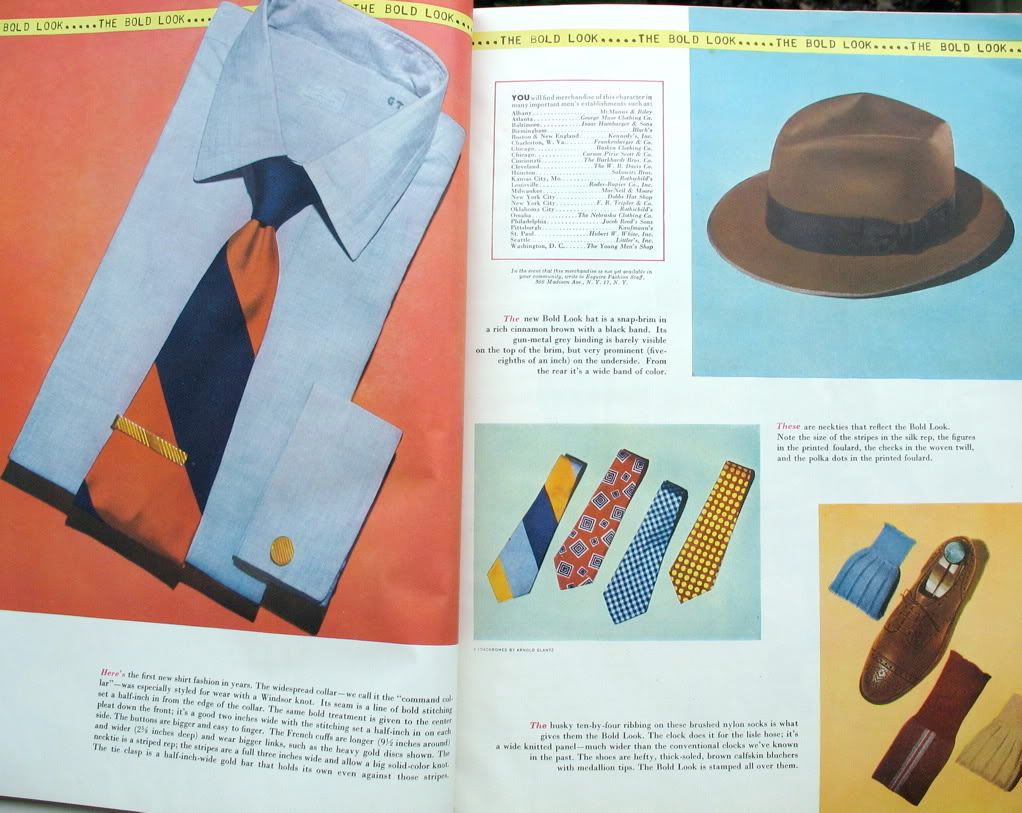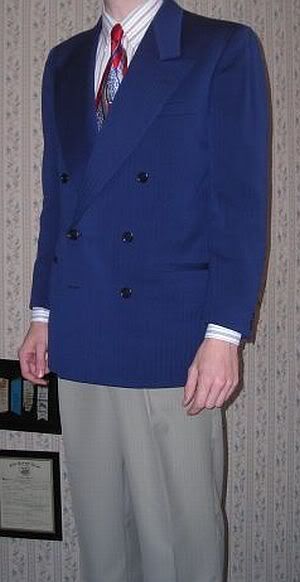...DIAMOND: Hello there, this is Diamond. If you happen to wake up some morning and spot something walking in front of your house and it looks like Santa Claus with jaundice, don't turn the hose on him, he's not on fire. He's just wearing the newest thing in men's fashions.They call it the Bold Look, and it's supposed to be the masculine answer to Dior's New Look for women. It's an answer, all right. Like walking up to your best girlfriend and slicing her down the middle with a broadsword.Now, if you haven't see it yet, just close your eyes and try and picture yourself in the Bold Look. Imagine, walking down 5th Avenue, very casual, decked out in a new bright purple non-shrinking suit, pastel shirt, yellow maybe, hand-painted tie, and argyle socks.Got it? What do you think? Pretty bad. About the only thing I can think of that's more gruesome is that little murder I got mixed up in last week...
Richard Diamond, Private Detective
"Mrs. William Baker, Klepto"
Aired September 3, 1949
Click photos to enlarge

The "Bold Look". What was this, according to 'Diamond', gruesome spectacle?
Quite simply, it was a new fashion in men's clothing beginning in the early to mid-1940s before being recognized as the dominant style in 1947 and 1948 by 'Apparel Arts' and 'Esquire', respectively. The Bold Look hailed lower button stance, lower gorge, wide ties with broad stripes and wild patterns as well as loose fitting suit jackets.
The Bold Look is thought to have come about mainly because of a change from the well-fitted, wasp-silhouette-giving suits of the 1920s and 1930s to looser, baggier suits in the 1940s. It also didn't help that returning servicemen, after the Second World War, demanded a break from the tight military uniforms and flocked to the new Bold Look.
Knowing this, one would have expected a similar movement to loose-fitting suits after the Great War. As it turns out, quite the opposite happened. Suit makers, as the Great War was coming to a close, wrongly thought that the returning Doughboys would demand tight, well-fitting suits just like the uniforms they had worn during the war. To the suit makers' horror and dismay the returning heros did not flock to the tight style. What a surprise!
But suit makers of the Second World War era learned a valuable lesson from their earlier counterparts. Thus the Bold Look was born.
Perhaps postwar men were also trying to seperate themselves from the prewar era by wearing a style very different from those styles of the past.
Click photos to enlarge
"Notice something new about American men? Well-groomed American men, that is -- the kind you always notice? They have a new look. We call it the BOLD LOOK.
You see it wherever you see Americans today. Walking down Pennsylvania Avenue in Washington. Coming out of our embassy in Moscow. Sitting around a conference table on Long Island, Entering the court of St. James in London. Or crossing Main Street in Peoria.
There’s a new look about them. It’s a self confident look and it’s as distinctive as it is distinguished. It’s a virile as football, as masculine as the Marine Corps -- as American as the Sunday comics. And new as it is, it’s as mature as the country itself, because it’s grown with the country.
...The newest styles that are appearing wherever the leaders of fashion gather exemplify the BOLD LOOK. Ties, shirts, socks: they’re designed with the accent on authority. They’re unrestrained; they use wide borders, big patterns, bold colors -- more colors. They have a look of definite good taste. Wear them, and you’ll have that look too.
The new shirts for example, are made with the "Command collar." This is a wide-spread collar with bold stitching a half-inch in from the edge rather than the usual eighth of an inch. The same bold treatment is given to the center pleat and the stitching on the cuffs. This is the first new shirt fashion in years and it’s especially styled for wear with the Windsor tie.
Neckties, in design and in color, are clear, sharp, bold. Checks are bigger, stripes are wider. Figures are bolder and more widely spaced. And the new polka dots are three-eighths of an inch in diameter.
There’s a new hat too. It’s a snap-brim in a rich cinnamon brown with a black band and gunmetal grey binding. The binding is barely visible on the top of the brim, but very prominent on the underside; Seen from the side and the rear it’s a wide band of color. And there’s more definite design in socks. Ribbing is wider, clocks are broader. The BOLD LOOK in shoes is massive. And jewelry gives a man a chance to go to town with confidence. Tie clasps are wide slabs of gold. Cufflinks are larger and heavier to match. Heavy gold-link keychains follow the trend.
...Those are some of the characteristics of the new BOLD LOOK, a look of self-confidence, good taste. Like as not, you yourself have been approaching the Bold Look with the Windsor knot and the spread collar. Those were just the first signs though - these newest fashions take up where they left off."
Click photos to enlarge
While I prefer the prewar look of well-fitted suits the Bold Look does have a certain element that makes it attractive. Perhaps it's the bright colors, the wild ties or the smooth, clean lines.
Here's my take on the Bold Look. Both the tie and jacket are of the Bold period. The jacket is made of a herringbone gabardine fabric that is almost electric in color under the right light, as the below photo shows. It has a 1949 union tag, pinning it right in the middle of the Bold Look era that lasted well into the 1950s. Note the low button stance and the low lapel gorge that was characteristic of the Bold Look.
Click photos to enlarge
Some photos and descriptions from the Fedora Lounge.



No comments:
Post a Comment